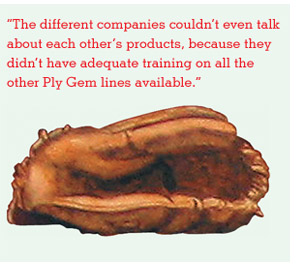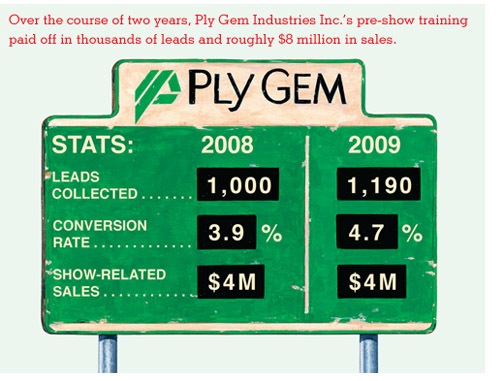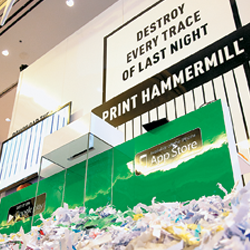case study |
 |
 aseball legend Babe Ruth once said, "The way a team plays as a whole determines its success. You may have the greatest bunch of individual stars in the world, but if they don't play together, the club won't be worth a dime." aseball legend Babe Ruth once said, "The way a team plays as a whole determines its success. You may have the greatest bunch of individual stars in the world, but if they don't play together, the club won't be worth a dime."
That is why the Bambino and his pinstriped crew typically spent about two months each spring learning to work as a team. Great individual players they might have been, but without some training and practice, even the Sultan of Swat knew his Bronx Bombers would have ended up looking more like Keystone Kops.
While Keith Pigues may not be in any hall of fame - yet - the chief marketing officer of Ply Gem Industries Inc. shared Babe Ruth's faith in training, and feared his team might stumble on the show floor at the 2008 International Builders' Show (IBS) without some serious preparation. That's because Ply Gem, which sells home-exterior building materials such as windows, siding, fencing, and railing, was consolidating its exhibit program. For the first time, the company planned to use one unified booth for its six building-material companies rather than allow each company to execute
its own exhibit-marketing strategy as Ply Gem had done in the past.
Pigues understood that playing together under the Ply Gem name at IBS would be a whole new ballgame. And no matter how good the individual salespeople might have been at trade shows before their
companies combined to form Ply Gem, each staffer needed to work from the same playbook if the company hoped to score any points at the show.
Not wanting to drop the ball, Pigues set three goals for IBS in 2008: First, he needed to build awareness of Ply Gem as a brand name. After all, there had never been a Ply Gem booth at IBS, and the company wanted to make a name for itself and present its umbrella brand to the public. Next, he needed his staff to gather high-quality sales leads, since lead collection in the past had been hit or miss in terms of quality interactions and documented qualifying information. Finally, he wanted a team that would be able to direct attendees to the right Ply Gem products quickly and efficiently, and maximize opportunities to cross sell attendees and convince them that
Ply Gem is a one-stop shop for all their building needs.
Fostering Team Spirit
At IBS in 2007, two of the subsidiaries under the Ply Gem umbrella had shown independently, and each of those companies also had its own marketing strategy and made its own exhibiting decisions. About 15 total employees had manned those exhibits. Like most years, each sales team arrived the day before the show opened, ready to saunter onto the
exhibit floor, meet and greet attendees,
and talk about the individual product lines they represented.
Many of the staff members representing the two Ply Gem subsidiaries had plenty of trade show experience. That experience at previous shows, though, came without training that focused on the importance of key messaging or properly qualifying attendees in the booth. Consequently, the quality of leads collected and the detailed information that was gathered with each lead was insufficient.
 According to Pigues, the individual companies that exhibited at IBS in 2007 collected what management considered to be a sufficient quantity of leads, but there was no concerted effort to track the leads or determine an ROI after the show. Still, everyone involved felt IBS was a success. According to Pigues, the individual companies that exhibited at IBS in 2007 collected what management considered to be a sufficient quantity of leads, but there was no concerted effort to track the leads or determine an ROI after the show. Still, everyone involved felt IBS was a success.
However, in the months after the 2007 show, Ply Gem decided to make a change. Separate booths and sales staffs, not to mention the duplicated
budgets required to feature different company names in different exhibits, seemed unnecessary and even counterproductive to Ply Gem's new agenda of branding itself as a one-stop shop. So Pigues began developing a new strategy for IBS in which Ply Gem would show all of its companies under one roof, branding each company and its product lines as belonging to the Ply Gem family.
In order to show attendees that Ply Gem offered a complete lineup of windows, veneers, vinyl siding, and fencing products, Pigues requested RFPs from MG Design Associates and three other design firms, asking each to present a booth plan that could bring six companies and several individual product lines together under one roof. But when MG Design pitched its plans for a 60-by-100-foot structure with upper-deck meeting spaces, the exhibit-design company told Pigues he needed more than a slick new booth to make his program deliver to its fullest extent.
"When we did our final presentation
on the booth, we told Ply Gem about the need for training. The different companies couldn't even talk about each other's products, because they didn't have adequate training on all the other Ply Gem lines available," says Gail Behun, vice president of sales at Pleasant Prairie, WI-based MG Design. "They were incredibly technically proficient in their own products. A sales guy who sold windows could give you the UV rating of every window off the top of his head. But he couldn't talk about vinyl siding. And he most certainly couldn't answer the all-important question: 'Why should I, as an attendee, care that all these disparate brands are now operating under the Ply Gem umbrella?'"
The booth MG Design proposed worked from a structural and branding standpoint to show attendees that the individual companies were part of the Ply Gem team. But it was the commitment to training his staff that sold Pigues on the design firm's overall plan. So he gave MG Design the OK to start building a Ply Gem booth and to develop a staff-training session.
Sure, having the right exhibit and branding messages would help Ply Gem accomplish its objectives, but Pigues now believed the key to his program's success would come more from the people staffing the booth than the booth itself. That's a belief echoed across the industry, according to the International Association of Exhibitions and Events, which found that 74 percent of exhibit managers believe staff training is an important factor in assuring ROI and ROO at trade shows and events.
Pigues recognized that the work salespeople do on the trade show floor is different than the work they do in the office or in the field selling to clients. "The time is compressed, and the objective is to get the best-qualified leads to pass on to the sales force," Pigues says. "MG Design convinced me that training was critical to help change the approach of my booth staff to work effectively in the exhibit-marketing environment."
And Pigues realized the way to teach that new approach, which would focus on selling Ply Gem as a one-stop shop for a variety of building materials, was not via trial and error with prospective customers during the show but via a structured pre-show training session that would prepare his staffers to hit the show floor running.
Leveling the Playing Field
In 2008, Pigues brought his 35 sales-staff members to IBS a day early so they could spend eight hours training for the show. The session, led by an MG Design training specialist, was set
up to focus on several key elements such as Ply Gem's corporate message as well as information on each company's products being shown in the booth. The staff learned how to ask effective probing questions, and how to evaluate attendees as lead prospects. Role-playing exercises included sessions on capturing leads, delivering key messages during a conversation, and directing attendees to the Ply Gem products that best fit their building needs.
"We had several training sessions devoted to our product categories so that everyone could work the booth with base-level knowledge on all our products," Pigues says. "Our focus was to train staffers to listen to and understand the attendees' needs, know which products best matched those needs, and then direct attendees to the right person in the booth for lengthier, more technical conversations on those other product lines."
In order to do that, each training lesson was followed by role-playing sessions where staff members had a chance to walk through some scenarios with co-workers playing the parts of attendees. The objective of these exercises was to practice communicating that Ply Gem is a one-stop shop, while obtaining detailed information on booth visitors' needs.
|
 |
 |
Staffing Statistics
According to Doug Ducate, president and CEO of the Center for Exhibition Industry Research (CEIR), exhibit-staff training is often one of the first casualties when budgets are cut. But training your booth staff is one of the smartest investments you can make in your trade show success. And various studies conducted by CEIR, the International Association of Exhibitions and Events, and EXHIBITOR magazine uncovered the following statistics that underscore the importance of pre-show training.
|
 |
 |
 |
Fifty-two percent of exhibit managers who conducted pre-show training reported lead increases of 20 percent or more. An additional 43 percent of respondents who implemented staff-training sessions saw leads increase by 10 to 20 percent.
|
|
 |
 |
 |
Sixty-eight percent of exhibit managers claim that a properly trained booth staff converts a higher percentage of booth visitors into qualified leads.
|
|
 |
 |
 |
Seventy-four percent of exhibit managers believe that staff training is an important factor in assuring ROI and/or ROO at trade shows and events.
|
|
 |
 |
 |
Ninety-four percent of trade show attendees look for and appreciate booth staffers who are knowledgeable about the products displayed in their exhibits.
|
|
 |
 |
 |
Seventy-five percent of booth staffers reported that they respond more favorably to professional trainers from outside their companies than to internal company representatives conducting training sessions.
|
|
 |
 |
 |
Still, despite the potential benefits of pre-show training, 73 percent of exhibit managers report their companies have no plans to invest in training efforts.
|
|
 |
 |
 |
Thirty-one percent of exhibitors provide no form of pre-show training or preparation for their staffers whatsoever. |
|
|
Before the show, Pigues and MG Design developed a variety of likely scenarios based on the various types of attendees they expected to visit the booth. Role-playing began with the staffer in each scenario warmly greeting another trainee pretending to be the attendee. Within each scenario, staffers were tasked with identifying the specific needs of the attendee, determining whether that visitor was a decision maker, gauging the magnitude of the opportunity either through the size of the attendee's company or the budget for his or her project, and then directing attention to all relevant products matching that attendee's unique needs.
Many of the scenarios involved staffers trying to determine which product line in a specific group matched what the attendee needed. For example, Ply Gem offers a variety of new-construction and replacement windows at various quality and price levels. So in one of the scenarios, staffers needed to determine which of those windows best met an attendee's needs, and then hand that attendee off to a co-worker who could give the appropriate product details.
At each step along the way, staffers
asked attendees if they had any other exterior building-material needs, and
- assuming they did - introduced that attendee to an expert for a related product line. "Our goal was to prepare the sales staff to assess opportunities quickly with effective questioning, zero in on the areas of greatest need for a visitor, and share the appropriate information about Ply Gem and its products," Pigues says.
With the training camp over and the show opening the next morning, Pigues was confident his staffers were ready to handle attendees in the booth like a slick infield turning a routine double play.
Game Time
When the show started, Ply Gem's newly trained staff went to work in a 60,000-square-foot booth that was split in half, with displays featuring the window and patio-door products on one side and the exterior siding, fencing, and railing products on the other. In the middle was a two-deck structure that featured three conference areas on the second level. Above the booth towered the Ply Gem logo, which also appeared on the reception desk. Furthermore, each individual company's display included the Ply Gem name and logo.
 Pigues says the use of role-playing made the sales staff's interactions with attendees go smoothly right from the start. "The training helped us improve everything about our interactions with booth visitors, from the initial greeting to the qualifying questions to the targeted discussions designed to capture lead information and classify the lead." Pigues says the use of role-playing made the sales staff's interactions with attendees go smoothly right from the start. "The training helped us improve everything about our interactions with booth visitors, from the initial greeting to the qualifying questions to the targeted discussions designed to capture lead information and classify the lead."
That improved interaction showed in the results from the 2008 show. While the company hadn't tracked leads or sales in 2007, the general feeling from the Ply Gem companies was that the number and quality of leads from the 2008 show represented a comparable home run worth of ROI. Pigues decided to use the 2008 show as a benchmark to which future IBS results could be compared.
"We captured nearly 1,000 qualified
leads in 2008," Pigues says, adding that part of the lead-capture training had been about gathering quality leads, not just swiping any old badge. Each lead was evaluated based on several criteria including whether the attendee expressed an interest in Ply Gem's products, and had current or upcoming construction projects with a need for Ply Gem materials.
By the time the next show rolled around, Ply Gem had converted 3.9 percent of the leads gathered at IBS in 2008 into new customers. Those new customers alone tallied up nearly $4 million in sales. Pigues also found proof that the role-playing activities surrounding product information and cross selling had paid off.
From the list of all qualified leads, 40 percent expressed interest in cross-buying opportunities. This result showed booth staffers were turning single sales into possible extra-base hits by asking the right questions about customers' needs and explaining how Ply Gem could meet all of those needs with its various brands and product lines. It also showed that attendees were looking at Ply Gem as a source for multiple products - not just the one with which they may have been familiar in the past.
"The focus of the training was on results, not just skills," says MG Design's Behun. "Developing skills is important, but making those skills turn into results and sales is what we try to emphasize."
One vital result, Pigues says, was being able to convey to those 1,000 qualified leads that Ply Gem could deliver an array of building products. "Where we were formerly six different companies, we're now one. To be able to deliver that 'one-stop shop' message consistently and to so many attendees is absolutely priceless."
Practice Makes Perfect
With the success of the 2008 show on the books, Pigues and the folks at MG Design wanted to turn 2008's home run into a grand slam in 2009 by evolving and improving the pre-show training session. This time, MG Design partnered with Keith Reznick of Creative Training Solutions, a trade show and sales training firm based in Voorhees, NJ, to build a new and improved session. Since most of the same staffers would be returning to IBS in 2009, they figured some of the training messages that seemed so vital in 2008 could now be downplayed.
For example, the idea that several well-known companies were now part of the Ply Gem family could be de-emphasized. The exhibit's signage was going to represent these companies more and more as product lines produced by Ply Gem rather than individual companies owned by Ply Gem. Furthermore, the industry had already spent a year soaking up the "one-stop shop" message, so repeating that did not seem as critically important.
Ply Gem was also facing the reality that the crowds at IBS in 2009 were likely to be smaller due to the economy. That meant the quantity of leads was much less important than the quality of the leads collected and the total sales value those leads represented. So to counter the attendance-related reality, Ply Gem had its staff focus even more on role-playing, with a very heavy emphasis on lead qualification and turning each visitor into a hard-core Ply Gem fan.
"In 2009, we increased pre-show role-playing by 50 percent," Pigues says. "It takes practice, practice, practice to get it right. Once again, we did all our training the day before the show, so we had plenty of time, but it was still fresh in their minds when they hit the show floor."
 Despite a 34-percent decrease in IBS attendance in 2009, Pigues says Ply Gem managed to increase the number of qualified leads it collected by 19 percent. What's more, the company improved its lead-conversion rate of new clients to 4.7 percent. And the sales figures from those clients increased incrementally over the nearly $4 million worth of sales in 2008. Despite a 34-percent decrease in IBS attendance in 2009, Pigues says Ply Gem managed to increase the number of qualified leads it collected by 19 percent. What's more, the company improved its lead-conversion rate of new clients to 4.7 percent. And the sales figures from those clients increased incrementally over the nearly $4 million worth of sales in 2008.
"Staffers typically treat their time on the show floor like little more than a family reunion with old friends and existing clients," Pigues says. "When people walk by, the conversation starts with 'Hey, how are you doing?' instead of focusing on what the company can do for that builder's needs. We want people to be friendly, and we want the booth to be inviting, but we want those conversations to be laced with key messages and qualifying questions. 'Are you the decision maker?' 'Do you have a budget?' 'What projects are you working on, and what size are they?' 'What other options are you considering?'"
By running his staff through its pre-game drills, Pigues kept his in-booth team on message, focusing on the important questions. Those friendly conversations became more productive - and his exhibit-marketing program simultaneously became more effective.?"Pre-show training has proven extremely effective in helping my staffers." Pigues says. "Also, practice makes perfect. But the time to perfect this new approach is during pre-show training, not while you're on the show floor with prospective customers. If you're proactive about training your staff, they'll hit the show floor ready and able to accomplish your objectives."
With a solid training regime, Pigues turned his booth staff into a lean, mean, lead-gathering machine. And even in the face of an economic curveball, the well-trained team was able to knock their results out of the park. Now that's the kind of effort that gets a team into the hall of fame.E
|
|
|
|




 aseball legend Babe Ruth once said, "The way a team plays as a whole determines its success. You may have the greatest bunch of individual stars in the world, but if they don't play together, the club won't be worth a dime."
aseball legend Babe Ruth once said, "The way a team plays as a whole determines its success. You may have the greatest bunch of individual stars in the world, but if they don't play together, the club won't be worth a dime." According to Pigues, the individual companies that exhibited at IBS in 2007 collected what management considered to be a sufficient quantity of leads, but there was no concerted effort to track the leads or determine an ROI after the show. Still, everyone involved felt IBS was a success.
According to Pigues, the individual companies that exhibited at IBS in 2007 collected what management considered to be a sufficient quantity of leads, but there was no concerted effort to track the leads or determine an ROI after the show. Still, everyone involved felt IBS was a success. 






 Pigues says the use of role-playing made the sales staff's interactions with attendees go smoothly right from the start. "The training helped us improve everything about our interactions with booth visitors, from the initial greeting to the qualifying questions to the targeted discussions designed to capture lead information and classify the lead."
Pigues says the use of role-playing made the sales staff's interactions with attendees go smoothly right from the start. "The training helped us improve everything about our interactions with booth visitors, from the initial greeting to the qualifying questions to the targeted discussions designed to capture lead information and classify the lead." Despite a 34-percent decrease in IBS attendance in 2009, Pigues says Ply Gem managed to increase the number of qualified leads it collected by 19 percent. What's more, the company improved its lead-conversion rate of new clients to 4.7 percent. And the sales figures from those clients increased incrementally over the nearly $4 million worth of sales in 2008.
Despite a 34-percent decrease in IBS attendance in 2009, Pigues says Ply Gem managed to increase the number of qualified leads it collected by 19 percent. What's more, the company improved its lead-conversion rate of new clients to 4.7 percent. And the sales figures from those clients increased incrementally over the nearly $4 million worth of sales in 2008.


